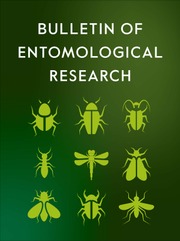No CrossRef data available.
Article contents
Optimising reference gene selection in unravelling Begomovirus-induced autophagy expression in Bemisia tabaci (Hemiptera: Aleyrodidae)
Published online by Cambridge University Press: 27 August 2025
Abstract
Gene expression can be quantified using the sensitive technique of quantitative reverse transcription real-time polymerase chain reaction. Inter-sample variances can be minimised through normalisation with an appropriate reference gene. Bemisia tabaci, a significant insect vector of the Begomovirus family, transmits the Tomato Leaf Curl Bangalore Virus, for which there is a dearth of information regarding appropriate reference genes for autophagy. The viral load surpasses the vector’s capacity when autophagy is activated, which is also detrimental to whiteflies, particularly concerning virus translocation. To mitigate this vector using a double-stranded RNA approach, a precise measurement of gene silencing is required. For this investigation, normalisation of housekeeping or internal control genes is necessary. The present work utilised software tools such as geNorm, NormFinder, and BestKeeper to assess the suitability of five reference genes, namely, α-tubulin, β-tubulin, elongation factor, actin, and sucrose synthase, for gene expression studies in viruliferous and non-viruliferous B. tabaci. The analysis of the data showed that β-tubulin, which exhibits more stable expression, is the best-ranked reference gene. Furthermore, the reference genes were verified using the target gene expression of atg3 (an autophagy gene). The current findings enable precise measurement of gene expression in begomovirus-induced autophagy conditions of B. tabaci.
Information
- Type
- Research Paper
- Information
- Copyright
- © The Author(s), 2025. Published by Cambridge University Press.
Footnotes
Authors with equal contribution


